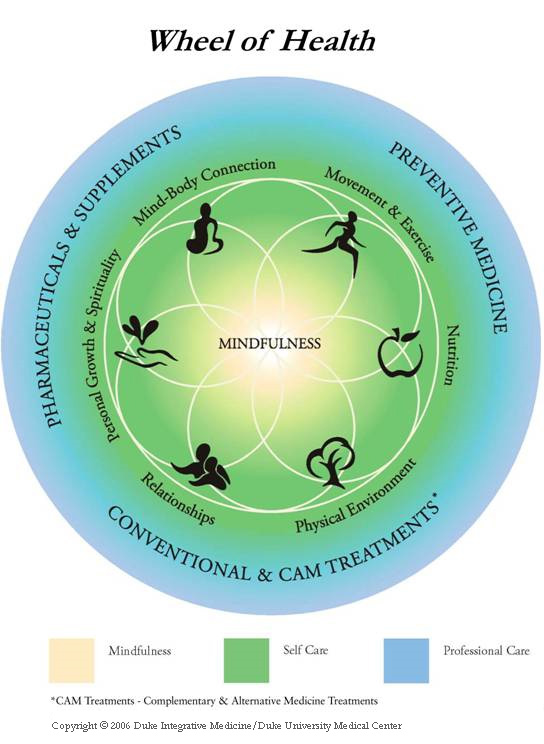Integrative Medicine


What is it?
Integrative medicine is a popular term nowadays that covers a broad range of practices that integrate traditional Western medicine with alternative and complementary medicine.
The National Center for Complementary and Integrative Health defines “integrative medicine” as a coordinated way of bringing together conventional and complementary and alternative approaches that have shown high-quality evidence-based effectiveness and safety. Alternative therapies often used with conventional medical care include acupuncture, guided imagery, hypnotherapy, yoga, among various others.
Practitioners of integrative medicine see patients as partners and work closely with you to ensure you are receiving the treatments you need. Integrative medicine addresses many factors, including the physical, emotional, social, spiritual, and environmental influences that affect a person’s health status.
Integrative medicine doesn’t replace the care you receive from your primary doctor. Rather, it offers a complement to existing treatments prescribed by your primary care doctor and other specialty doctors you currently see. In fact, once you have met with an integrative medicine practitioner, they will send your primary provider a summary of your visit a list of therapies recommended for you.
Core philosophy
The basics
According to the American Board of Physician Specialties (ABPS), the principles that define Integrative Medicine are:
- A close partnership between the patient and physician.
- Use of both conventional and alternative medicines to treat the patient.
- An emphasis on non-invasive treatments, whenever possible.
- The commitment to ensuring that medical diagnoses and treatments are based on scientifically sound research.
- Consideration of all factors that influence health, wellness, and disease, including mind, spirit, and community as well as body.
- An emphasis on health promotion and illness prevention through healthy living.
In addition, Andrew Weil MD, one of the pioneers in integrative medicine adds the following two additional principles:
- A philosophy that neither rejects conventional medicine nor accepts alternative therapies uncritically.
- Training of practitioners to be models of health and healing, committed to the process of self-exploration and self-development.
One important aspect here is that integrative medicine encourages people to take responsibility for their health and well-being. This is rooted in the concept that a person can heal naturally, a core concept in many alternative treatments.
Integrative medicine providers recommend modalities and treatments that have been investigated for safety and usefulness. For patients with cancer and cancer survivors, for example, some integrative modalities may help with many side effects. For instance, acupuncture may be used for hot flashes, reiki for pain and anxiety, etc.
Individual approaches
While the implementation approaches of different integrative practices or centers may differ, the core philosophy remains. For example, experts at Duke Integrative Medicine developed “The Wheel of Health”, which is Duke’s unique approach to integrative medicine.
The Wheel of Health has three concentric circles that represent the primary elements of optimal health:
- Mindfulness: At the heart of health is mindfulness, the practice of staying alert to your physical, mental, social, and spiritual states. This non-judgmental awareness enables individuals to recognize symptoms as they emerge, which is when they are most readily treatable. This is the critical core of well-being, on which the other elements are based.
- Self-care: Individuals are encouraged to explore the interplay of the ways they can improve or maintain their health. Important areas for self-care are relationships, the physical environment, nutrition, movement and exercise, the mind-body connection, and personal growth and spirituality.
- Professional care: Recognizing symptoms early is key to diagnosing health problems when they are most treatable, and awareness of the need for professional care is an integral component of the integrative approach to medicine. Professional care includes pharmaceuticals and supplements, preventive medicine, and conventional and CAM treatments.
Coordinating all of the care given to a patient is a cornerstone of the integrative medicine approach. Your primary care physician should work in tandem with such practitioners as your integrative medicine physician, integrative health coach, nutritionist, massage therapist, and acupuncturist.
Integrative and functional medicine
Often times integrative medicine is confused with functional medicine. Functional medicine focuses on underlying causes of illness, influenced by genetic predispositions and the environment in which one lives. Its primary focus is the optimal health of the body and it believes that one condition can have many causes and that one cause can have many conditions.
Integrative medicine functions in a similar, albeit different way as it seeks to evaluate the patient as a whole. It incorporates mental, emotional physical, and spiritual needs into the patient’s unique health equation.
History
A movement towards better health
The deterioration of the patient-provider relationship, the overuse of technology, and the inability of the medical system to treat chronic disease adequately have contributed to rising interest in complementary and alternative medicine (CAM) in the last few decades. The public sent this message with their pocketbooks. In fact, there were more visits to CAM providers in the early 1990s than to all primary care medical physicians. This trend continued throughout the 1990s and continues to remain strong today.
The popularity of CAM therapies created a need for research in these areas. In 1993, and Office of Alternative Medicine started within the National Institutes of Health (NIH). The initial budget was $2 million, a fraction of $80 billion budget of the NIH. The office was later upgraded to the National Center for Complementary and Alternative Medicine (NCCAM). In 2014, the name changed to the National Center for Complementary and Integrative Health (NCCIH).
At first, researchers tried to use traditional methods to learn about CAM therapies. These methods were sufficient for studying some areas, such as botanicals. The limitations of the reductionist model became apparent, however, when applied to more dynamic systems of healing such as homeopathy, traditional Chinese medicine, and energy medicine, like reiki.
Expanding reach
In 1997, Andrew Weil started the first fellowship program in integrative medicine at the University of Arizona. This 2-year clinical and research fellowship was created to train physicians in the science of health and healing and to teach more about therapies that were not part of Western medical practice. Since then, other fellowship programs were created, as well as projects to incorporate integrative medicine into 4-year medicine training models.
The NIH awarded R25 grants to medical schools across the country to bring these concepts into medical school curriculums. The Academic Consortium for Integrative Health and Medicine (ACIHM) now comprises more than 62 medical schools across the United States and Canada. It brings academic leaders together to transform health care through rigorous scientific studies, new models of clinical care, and innovative educational programs that integrate biomedicine, the complexity of humans, and the rich diversity of therapeutic systems.
An ongoing evolution
With the growth of scientific research regarding CAM therapies, the labels once used to classify them were no longer adequate. In fact, the very term “complementary and alternative” made CAM treatments sound second class. Signs of this evolution away from CAM are the name changes of many educational and research organizations supporting its mission. Examples of these adjustments in names are:
National Center for Complementary and Alternative Medicine (NCCAM) -> National Center for Complementary and Integrative Health (NCCIH)
The Consortium of Academic Health Centers for Integrative Medicine (CAHCIM) -> Academic Consortium for Integrative Medicine and Health (ACIMH)
The American Board of Integrative and Holistic Medicine (ABIHM) -> Academy of Integrative Health and Medicine (AIHM)
In 2006, a report from the American College of Physicians stated that the primary care system was at grave risk of collapse due to a dysfunctional financing and delivery system. This crisis has led to proposals for a restructuring of health care that resonate with the philosophy of integrative medicine. The field of integrative medicine was created not to fragment the medical culture further by devising another silo of care. Rather, it encourages the incorporation of health and healing into the larger medical model.
In 2013, The American Board of Integrative Medicine (ABIOM) was formed through the American Board of Physician Specialties (ABPS). The first diplomats were awarded board certification in 2014. Although grandfathering was allowed initially, fellowship training in integrative medicine was required after 2016 to sit for the board exam.
Benefits and uses
Complementing integrative medicine with your regular primary care can bring multiple benefits as you can approach healing from different angles. By blending scientifically sound allopathic methods with the safest and most efficient solutions of alternative medicine, patients receive all-encompassing care that truly promotes health.
Among its many benefits, the five main reasons that integrative medicine stands out are:
Focuses on prevention
Unlike conventional health care, integrative medicine primarily focuses on prevention to support optimal health prior to disease development. It also reinforces the body’s innate ability to heal itself, utilizing lifestyle enhancements, mind-body medicine, and in-depth patient education.
A holistic approach
An integrative physician always focuses on the whole person rather than on seemingly separate organ-specific health problems. By considering each patient’s immediate environment, activity levels, lifestyle choices, social relationships, and emotional well-being, the practitioner can offer in-depth answers to one’s problems.
A model based on relationship and collaboration
An open, honest, and collaborative patient-physician relationship is the mantra inside an integrative physician’s office. Integrative practitioners deliberately avoid the transactional, one-sided approach that is common in today’s medical environment.
Personalized care
When it comes to individual health, one size does not fit all. The goal of an integrative practitioner is to carefully uncover all components that affect their patients’ physiological and emotional well-being. There is also a commitment to finding the root cause where cookie-cutter solutions don’t always apply.
Conventional and complementary treatments supported by science
By blending scientifically sound allopathic methods with the safest and most efficient solutions of alternative medicine, patients receive all-encompassing care that truly promotes health, from prevention to highly effective disease management.
Who practices it
In addition to having the education and certification in their profession/specialty, physicians can be certified in integrative medicine. The American Board of Physician Specialties offers an integrative medicine certification through the American Board of Integrative Medicine.
Completion of the board certification shows that the practitioner has proven knowledge and experience in integrative medicine practices. It also reflects the physician’s commitment to adhere to the Medical Code of Ethics. However, this body requires conventional degrees such as MDs or DOs and board certification from a specific recognized specialty.
Integrative medicine practitioners include, however, professionals of many more disciplines – medical doctors, nurse practitioners, doctors of osteopathic medicine, naturopaths, massage therapists, etc. The educational and accreditation requirements for these professions vary widely, as does the regulation of these specialties. Furthermore, certification in integrative medicine (if any), may come from other lesser-known bodies or academic institutions that cater to these less conventional practices.
If you’re looking for an integrative medicine practitioner, look for someone who is fully accredited in their specialty and transparent about their experiences and belief system. Good integrative medicine practitioners see their patients not only as partners but are also willing to work collaboratively with other healthcare professionals responsible for your care.
What to expect
A consult is typically an hour-long appointment. The Integrative Medicine physician or physician assistant will meet with you, take a detailed personal and family history, and go over your medications, supplements, and diet. Conventional laboratory testing is also quite common during your first visit.
Since each patient is unique, the recommendations are tailored to the individual’s health and overall goals. The wellness plans that the integrative doctor develops usually focus on natural remedies that don’t interfere with traditional medications. They also include complementary approaches as necessary, such as massage, meditation, acupuncture, etc.
Typically integrative doctors have affiliations with alternative practitioners across practices, or at the very least, they will recommend reputable professionals in your area. Most insurance companies cover integrative medicine appointments as they would any medical specialty appointment. However, they may or may not cover complementary therapies recommended by the integrative doctor. Therefore, you should check with your insurance before taking any additional treatment.
The doctor will propose follow-up appointments to track progress. The frequency of the follow-ups will vary depending on your condition and the doctor’s assessment. In general, seeing an integrative doctor will likely feel like a more comforting and personal doctor experience, with the additional incorporation of techniques that you may not have experienced before (like acupuncture, for example).
Interesting facts
The concept of integrative medicine has become quite popular in the last few years. Below are some facts about this approach to health:
- Dr. Robert Bonakdar, director of pain management at Scripps Center for Integrative Medicine in La Jolla, California, said that over the past few years he has seen “two to three times more referrals” in which the patient or provider is asking for integrative therapies.
- Dr. Andrew Weil, an internationally recognized pioneer of integrative and holistic health, told Healthline that approximately half of America’s medical schools have signed on to an integrative medicine consortium.
- A retrospective study in Texas showed that patients who received integrative medicine were more likely to have reduced pain that resulted in an approximately 4% decrease in hospital costs.
- The University of Michigan introduced an integrative medicine clinic in 2003 and investigate the effect by surveying 85 patients about their experience. Patients were happy with their experience and found integrative regimes helpful in improving their mental and emotional well-being in addition to improving their symptoms.
- One potential drawback to the integrative approach is that it often requires multiple teams who may disagree on conflicting treatment avenues. An approach to minimize this is to have one main team that consults other specialists for different patient needs.
Closing statement
The philosophy of health based on a balance of mind, body, and spirit is not new or unique to integrative medicine. This understanding has been around since early times. What we call it is not important, but the underlying concepts are.
Integrative medicine can provide the balance needed to create the best possible medicine for both the physician and the patient. We will know that we are near this balance when we can drop the term integrative. The integrative medicine of today will then simply be the good medicine of the future.
Newsletter
Sign up for emails to get the scoop on our latest articles, new developments and more.

